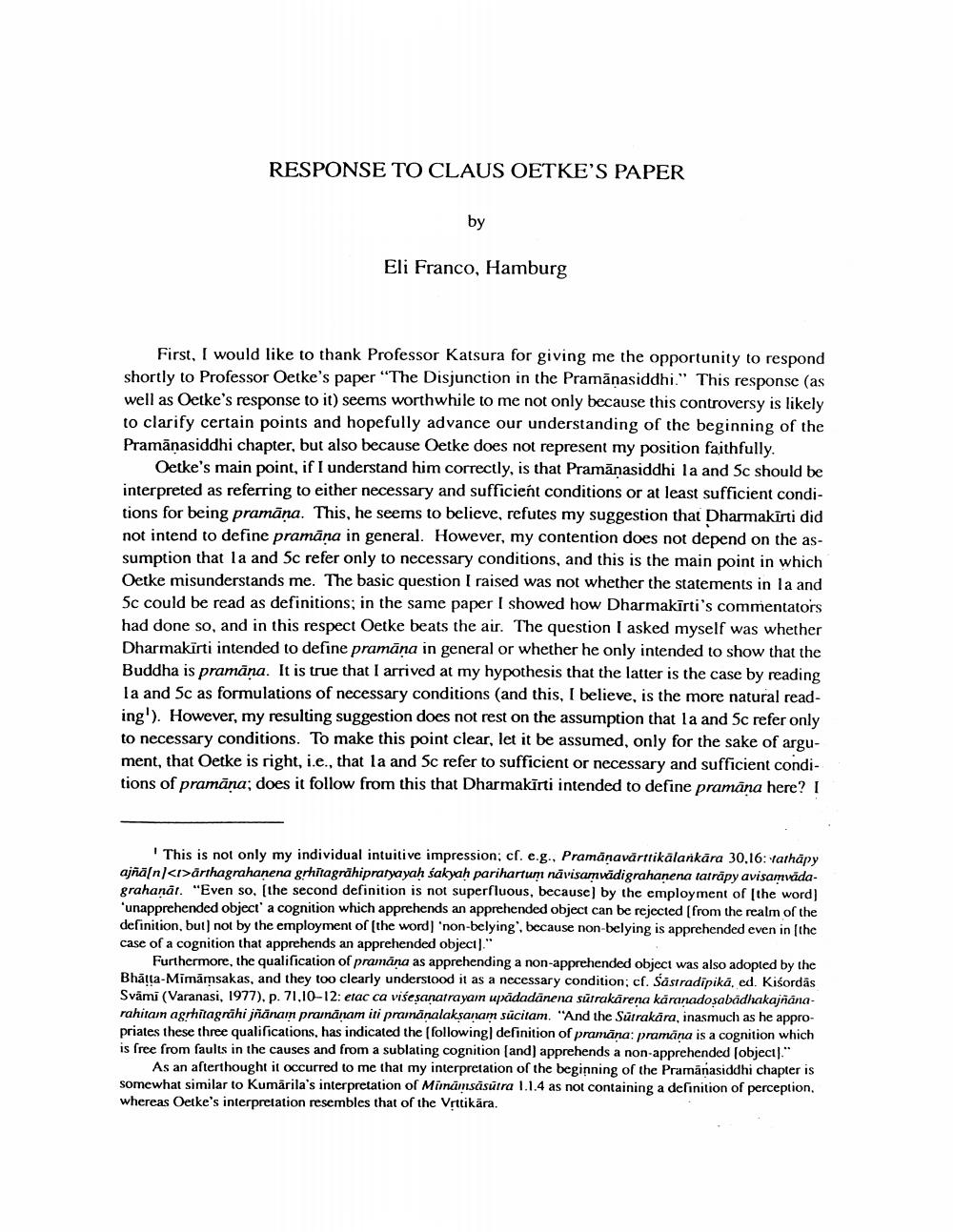________________
RESPONSE TO CLAUS OETKE'S PAPER
by
Eli Franco, Hamburg
First, I would like to thank Professor Katsura for giving me the opportunity to respond shortly to Professor Oetke's paper "The Disjunction in the Pramānasiddhi." This response (as well as Oetke's response to it) seems worthwhile to me not only because this controversy is likely to clarify certain points and hopefully advance our understanding of the beginning of the Pramānasiddhi chapter, but also because Oetke does not represent my position faithfully.
Oetke's main point, if I understand him correctly, is that Pramānasiddhi la and 5c should be interpreted as referring to either necessary and sufficient conditions or at least sufficient conditions for being pramāna. This, he seems to believe, refutes my suggestion that Dharmakirti did not intend to define pramāna in general. However, my contention does not depend on the assumption that la and 5c refer only to necessary conditions, and this is the main point in which Oetke misunderstands me. The basic question I raised was not whether the statements in la and Sc could be read as definitions; in the same paper I showed how Dharmakirti's commentators had done so, and in this respect Oetke beats the air. The question I asked myself was whether Dharmakirti intended to define pramāna in general or whether he only intended to show that the Buddha is pramāna. It is true that I arrived at my hypothesis that the latter is the case by reading la and 5c as formulations of necessary conditions (and this, I believe, is the more natural reading'). However, my resulting suggestion does not rest on the assumption that la and 5c refer only to necessary conditions. To make this point clear, let it be assumed, only for the sake of argument, that Oetke is right, i.e., that la and Sc refer to sufficient or necessary and sufficient conditions of pramāna; does it follow from this that Dharmakīrti intended to define pramana here? I
This is not only my individual intuitive impression; cf. e.g., Pramānavärttikälankāra 30.16: tathāpy ajnaln/<i>ärthagrahanena grhitagrähipratyayah sakyah parihartum nävisamvädigrahanena taträpy avisamvidagrahanåt. "Even so, (the second definition is not superfluous, because) by the employment of the word) 'unapprehended object' a cognition which apprehends an apprehended object can be rejected (from the realm of the definition, but not by the employment of the word 'non-belying because non-belying is apprehended even in the case of a cognition that apprehends an apprehended object)."
Furthermore, the qualification of pramana as apprehending a non-apprehended object was also adopted by the Bhālta-Mimamsakas, and they too clearly understood it as a necessary condition; cf. Šāstradipika, ed. Kisordás Svāmi (Varanasi, 1977). p. 71,10-12: etac ca visesanatrayain upradadanena surrakārena käranadosabādhakajnánarahitam agrhitagrāhi jñānam pravānam iti pramänalaksanam sūcitam. "And the Sūtrakära, inasmuch as he appropriates these three qualifications, has indicated the following definition of pramāna: pramana is a cognition which is free from faults in the causes and from a sublating cognition (and) apprehends a non-apprehended (object)."
As an afterthought it occurred to me that my interpretation of the beginning of the Pramanasiddhi chapter is somewhat similar to Kumarila's interpretation of Mināmsāsūtra 1.1.4 as not containing a definition of perception, whereas Oetke's interpretation resembles that of the Vrttikära.




